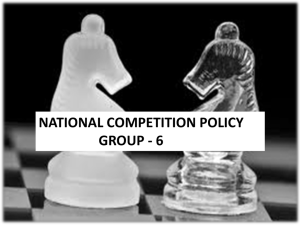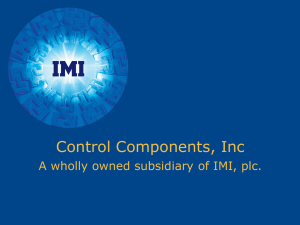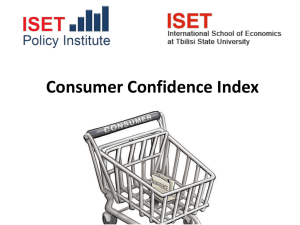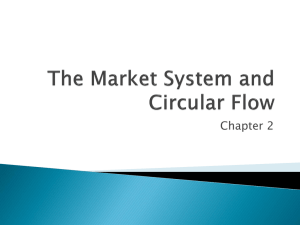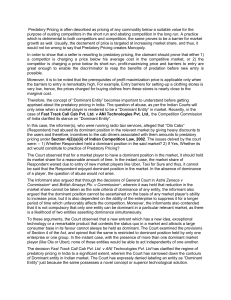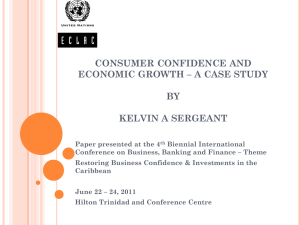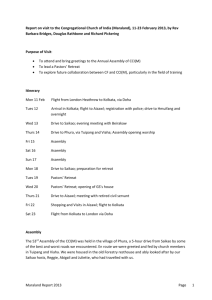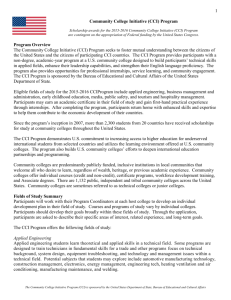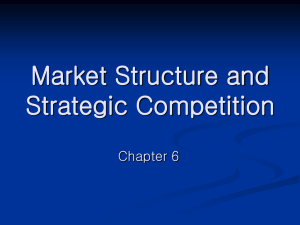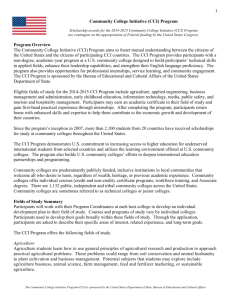Presentation
advertisement
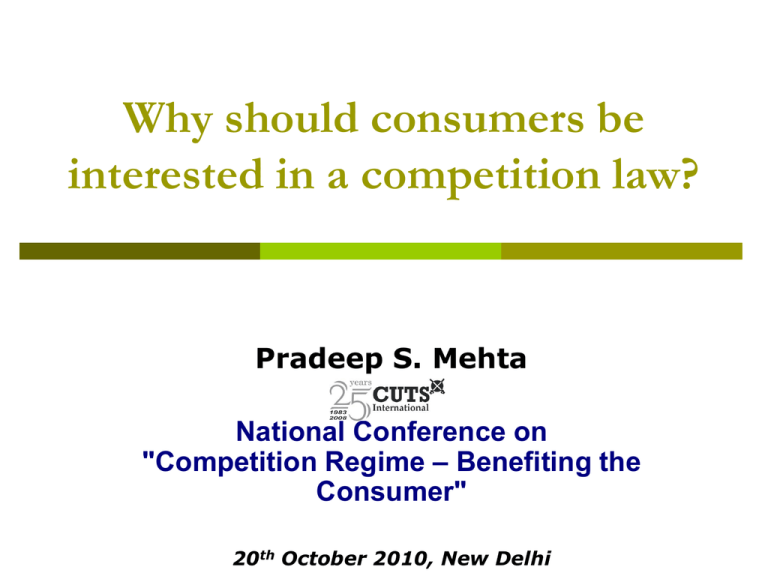
Why should consumers be interested in a competition law? Pradeep S. Mehta National Conference on "Competition Regime – Benefiting the Consumer" 20th October 2010, New Delhi What is Competition? The process of rivalry between firms striving to gain sales and make profits Motive: self-interest, but outcome mostly beneficial for the society Competition is not just an event, but a process It is not automatic – needs to be nurtured 2 Types of Competition Price Competition: Winning customers by lowering price Non-price Competition: Winning customers by advertising, offering after-sales-services, using sale promotion tools, etc. 3 Ways of Competition Fair Competition: Fair means such as producing quality goods, becoming cost-efficient, optimising the use of resources, best technology, research & Development, etc. Unfair Competition: Unfair means such as fixing price with the rivals, predatory pricing, disparaging or misleading advertisements, etc. 4 Benefits from Competition Efficiency Innovation Check on concentration Economic growth (wealth and job creation) Consumer welfare gains: Lower prices, Better quality, Freedom of choice and Easy access 5 Competition Law Aims to protect process of competition and not competitors Consist of a set of rules to curb Anti Competitive Practices (ACPs) Sets up the Competition Authority: Competition Commission of India (CCI) and Competition Appellate Tribunal (COMPAT) Over 120 countries have adopted Competition Law 6 Myths & Realities Myth: Competition policy and law will allow foreign firms to come in and undermine domestic firms. Reality: Effect of foreign entry depends upon capabilities of domestic firms. Competition Law protects domestic firms from ACPs of foreign firms. Example: Multinational Vitamin Cartel case. 7 Myths & Realities Myth: Competition policy and law are the tools for rich and urban societies. Reality: Poor do benefit from action against competition abuses, if they can access justice. Example: Rukmini Devi in Rashmi, Chittorgarh 8 Myths & Realities Myth: Competition law and policy works for the rich and affluent sections only. Reality: Competition law and policy can also benefit the poor Example: Tied selling at government ration shops 9 Evolution of Competition Law in India The first legislation Monopolies and Restrictive Trade Practices Act, 1969, proved inadequate. The Competition Act 2002, was subsequently enacted due to strong lobbying by the consumer movement, lead by CUTS in 1990s. 10 Action Components of Competition Law Anticompetitive practices, such as Cartels (Section 3) Abuse of Dominance (Section 4) Mergers and Acquisitions (Section 5 & 6) Competition Advocacy (Section 49) 11 Collusion and other ACPs (Sec 3) “Our competitors are our friends, our customers are the enemy”-Archer Daniels Midland! Cartel is an agreement between firms to act in concert on prices, production levels or territories. E.g. Cable TV in cities Other anti-competitive practices, such as tied sales E.g. Gas connection and gas stoves Razor blades with sugar School uniforms and stationery Branded medicines/tests 12 Abuse of Dominance (Sec 4) Dominance means having authority or control. Cause of concern is not dominance but its abuse. Abuse of Dominance: 1. Exploitative practices: excessive pricing, discrimination or tied selling or IPR abuses Eg. Monsanto-Mahyco pricing of Bt Cotton seeds 2. Exclusionary practices: predatory pricing and refusal to deal. Eg. Truck unions not allowing non-member trucks 13 Combinations (Sec 5 & 6) Combinations include mergers: a fusion between two or more firms. Takeover/acquisition: purchase of all or sufficient number of shares of other firm(s). Cause of concern is not Combinations but its likelihood to result in monopoly or dominance in market. Eg. Recent takeover of Indian pharma companies without any merger review 14 Competition Authority Two tier agency created as per the provisions of the Competition Act, 2002 Competition Commission of India (CCI) Competition Appellate Tribunal (COMPAT) CCI assisted by the Director General COMPAT hears appeals and can also provide compensation Ultimate appeal at the Supreme Court 15 Other functions of CCI Perform the function of competition advocacy effectively and promote competition culture E.g. RBI favouring public sector banks Cooperation with other regulatory agencies E.g. With sector regulators on competition issues Cooperation with other competition agencies E.g. With competition agencies abroad 16 Challenges for India Absence of competition culture Lack of competent and experienced staff Government support is not always assured Vested interests (political-economy aspects) Lack of clarity on overlap between the competition authority and sector regulators Role of consumers/civil society Weakness in dissemination/communication 17 Competition Enforcement and Consumer Welfare Anti Competitive Practices restricting access Competition Authority’s Enforcement Actions Poor quality goods/services by a firm abusing dominant position Tied-selling restricting consumer choice Anti Competitive Practices leading to excessive prices ACCESS QUALITY Consumer Welfare CHOICE PRICE 18 Conclusions Competition enforcement leads to consumer welfare directly and indirectly Stakeholders need to recognise their role in promoting competition Policymakers/Government need to prioritise competition reforms CCI to remain independent CCI to create a public buy in Consumer movement: natural allies of a competition regime 19 THANK YOU! psm@cuts.org www.ccier-cuts.org 20


